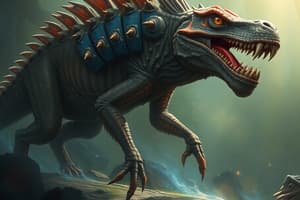Podcast
Questions and Answers
What is the main function of the vertebral column in vertebrates?
What is the main function of the vertebral column in vertebrates?
- To support the body's weight
- To produce milk for young
- To protect the brain and spinal cord (correct)
- To lay eggs
Which of the following classes of vertebrates is characterized by being warm-blooded and having feathers?
Which of the following classes of vertebrates is characterized by being warm-blooded and having feathers?
- Mammalia
- Reptilia
- Amphibia
- Aves (correct)
What is the term for the internal skeleton made up of bone and cartilage in vertebrates?
What is the term for the internal skeleton made up of bone and cartilage in vertebrates?
- Endoskeleton (correct)
- Axial skeleton
- Vertebrae
- Appendicular skeleton
Which type of muscle helps move substances through the body, such as in the digestive system?
Which type of muscle helps move substances through the body, such as in the digestive system?
What is the term for the individual bones that make up the vertebral column?
What is the term for the individual bones that make up the vertebral column?
Which of the following is a characteristic of vertebrates during embryonic development?
Which of the following is a characteristic of vertebrates during embryonic development?
Flashcards are hidden until you start studying
Study Notes
Characteristics of Vertebrates
- Possess a vertebral column (backbone) made up of vertebrae
- Have a central nervous system (brain and spinal cord) enclosed in the vertebral column
- Possess a cranium (skull) that encloses and protects the brain
- Have a defined head and tail region
- Possess a dorsal hollow nerve cord (spinal cord)
- Have pharyngeal slits (gill arches) during embryonic development
Classification of Vertebrates
- Classes:
- Mammalia (mammals): warm-blooded, hair, produce milk for young
- Aves (birds): warm-blooded, feathers, lay eggs
- Reptilia (reptiles): cold-blooded, scales, lay eggs
- Amphibia (amphibians): cold-blooded, moist skin, lay eggs
- Pisces (fish): cold-blooded, gills, lay eggs
Vertebrate Skeleton
- Axial skeleton: vertebral column, skull, ribs, and sternum
- Appendicular skeleton: limbs, pelvis, and shoulder girdle
- Endoskeleton: internal skeleton made up of bone and cartilage
- Vertebrae: individual bones that make up the vertebral column
Muscular System of Vertebrates
- Skeletal muscles: voluntary muscles that attach to bones and help move the body
- Smooth muscles: involuntary muscles that help move substances through the body (e.g., digestive system)
- Cardiac muscles: involuntary muscles that make up the heart and help pump blood
- Muscle fibers: bundles of muscle cells that contract and relax to produce movement
Studying That Suits You
Use AI to generate personalized quizzes and flashcards to suit your learning preferences.




